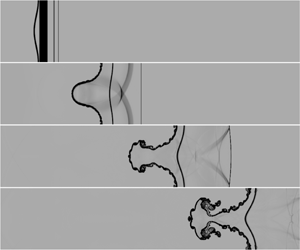Crossref Citations
This article has been cited by the following publications. This list is generated based on data provided by
Crossref.
Zhou, Ye
Groom, Michael
and
Thornber, Ben
2020.
Dependence of Enstrophy Transport and Mixed Mass on Dimensionality and Initial Conditions in the Richtmyer–Meshkov Instability Induced Flows1.
Journal of Fluids Engineering,
Vol. 142,
Issue. 12,
Jiang, Yazhong
Wen, Chih-Yung
and
Zhang, Deliang
2020.
Space–Time Conservation Element and Solution Element Method and Its Applications.
AIAA Journal,
Vol. 58,
Issue. 12,
p.
5408.
Uy, Ken Chun Kit
Shi, Lisong
Hao, Jiaao
and
Wen, Chih-Yung
2020.
Linear stability analysis of one-dimensional detonation coupled with vibrational relaxation.
Physics of Fluids,
Vol. 32,
Issue. 12,
Zhou, Ye
Williams, Robin J.R.
Ramaprabhu, Praveen
Groom, Michael
Thornber, Ben
Hillier, Andrew
Mostert, Wouter
Rollin, Bertrand
Balachandar, S.
Powell, Phillip D.
Mahalov, Alex
and
Attal, N.
2021.
Rayleigh–Taylor and Richtmyer–Meshkov instabilities: A journey through scales.
Physica D: Nonlinear Phenomena,
Vol. 423,
Issue. ,
p.
132838.
Liang, Yu
and
Luo, Xisheng
2021.
On shock-induced heavy-fluid-layer evolution.
Journal of Fluid Mechanics,
Vol. 920,
Issue. ,
Li, Haifeng
Tian, Baolin
He, Zhiwei
and
Zhang, Yousheng
2021.
Growth mechanism of interfacial fluid-mixing width induced by successive nonlinear wave interactions.
Physical Review E,
Vol. 103,
Issue. 5,
Li, Xinliang
Fu, Yaowei
Yu, Changping
and
Li, Li
2021.
Statistical characteristics of turbulent mixing in spherical and cylindrical converging Richtmyer–Meshkov instabilities.
Journal of Fluid Mechanics,
Vol. 928,
Issue. ,
Liang, Yu
2022.
The phase effect on the Richtmyer–Meshkov instability of a fluid layer.
Physics of Fluids,
Vol. 34,
Issue. 3,
Guo, Wenxuan
and
Zhang, Qiang
2022.
Quantitative theory for spikes and bubbles in the Richtmyer−Meshkov instability at arbitrary density ratios in three dimensions.
Physics of Fluids,
Vol. 34,
Issue. 7,
Liang, Yu
and
Luo, Xisheng
2022.
On shock-induced evolution of a gas layer with two fast/slow interfaces.
Journal of Fluid Mechanics,
Vol. 939,
Issue. ,
Wang, Rui
Song, Yang
Ma, Zongqiang
Ma, Dongjun
Wang, Lili
and
Wang, Pei
2022.
The transition to turbulence in rarefaction-driven Rayleigh–Taylor mixing: Effects of diffuse interface.
Physics of Fluids,
Vol. 34,
Issue. 1,
Liang, Yu
2022.
Fundamental Studies of Shock-Driven Hydrodynamic Instabilities.
p.
103.
Wang, Rui
Song, Yang
Ma, Zongqiang
Zhang, Cunbo
Shi, Xiaofeng
Wang, Lili
and
Wang, Pei
2022.
Transitional model for rarefaction-driven Rayleigh−Taylor mixing on the diffuse interface.
Physics of Fluids,
Vol. 34,
Issue. 7,
Wang, Rui
Song, Yang
Ma, Zongqiang
Zhang, Yang
Wang, Jun
Xu, Yaofeng
Wang, Lili
and
Wang, Pei
2023.
Scale-to-scale energy transfer in rarefaction-driven Rayleigh–Taylor instability-induced transitional mixing.
Physics of Fluids,
Vol. 35,
Issue. 2,
Liang, Yu
Liu, Lili
Luo, Xisheng
and
Wen, Chih-Yung
2023.
Hydrodynamic instabilities of a dual-mode air–SF6 interface induced by a cylindrically convergent shock.
Journal of Fluid Mechanics,
Vol. 963,
Issue. ,
Zhang, Duo
Ding, Juchun
Li, Ming
Zou, Liyong
and
Luo, Xisheng
2023.
Effects of reverberating waves and interface coupling on a divergent Richtmyer–Meshkov instability.
Journal of Fluid Mechanics,
Vol. 975,
Issue. ,
Wen, Chih-Yung
Jiang, Yazhong
and
Shi, Lisong
2023.
Space–Time Conservation Element and Solution Element Method.
Vol. 13,
Issue. ,
p.
77.
Liang, Yu
and
Luo, Xisheng
2023.
Review on hydrodynamic instabilities of a shocked gas layer.
Science China Physics, Mechanics & Astronomy,
Vol. 66,
Issue. 10,
Chen, Chenren
Wang, He
Zhai, Zhigang
and
Luo, Xisheng
2023.
Attenuation of perturbation growth of single-mode SF6–air interface through reflected rarefaction waves.
Journal of Fluid Mechanics,
Vol. 969,
Issue. ,
Liang, Yu
and
Luo, Xisheng
2023.
Hydrodynamic instabilities of two successive slow/fast interfaces induced by a weak shock.
Journal of Fluid Mechanics,
Vol. 955,
Issue. ,
